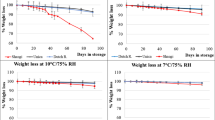Abstract
Tubers of three potato cultivars were stored at room temperature (20–39°C, 30–75% RH), under an insulated storage run on passive evaporative cooling (16–30°C, 70–90% RH) and a refrigerated storage (2–4°C, 90–95% RH) for 14 weeks and studied periodically for storage losses, reducing sugar content and dry matter percent of tubers, in order to explore the possibility of storing potatoes for processing at higher temperatures. Physiological losses in tubers remained less than 10% until 12 weeks of storage under evaporatively cooled storage. Reducing sugar contents increased by only 52.4–242.1% in tubers stored in evaporatively cooled storage as compared to 90.5–484.2% increase in tubers stored in refrigerated storage until 14 weeks. Potatoes stored in evaporatively cooled store were more suitable for processing into chips and french fries due to lower physiological losses and lower reducing sugar content of tubers.
Similar content being viewed by others
References
Brody J (1969) Pointers on potatoes. Food Engg 41: 124–132
Burton WG (1966) The Potato, 2nd edn. H. Veenman and Zonen, NV, Wageningen, The Netherlands, pp. 128–130
Burton WG (1973) Physiological and biochemical changes in the tuber as affected by storage conditions. Proceedings 5th Triennial Conference of European Association of Potato Research, Norwich 1972, p. 63.
Habib AT, Brown HD (1957) Role of reducing sugars and amino acids in the browning of potato chips. Food Technol 11: 85–89.
Hanes CS (1929) An application of the method of Hangedorn and Jenson to the determination of larger quantities of reducing sugars. Biochem J 33: 99–106
Hingorani SK, Addy SK (1953) Factors influencing bacterial soft rot of potatoes. Indian Phytopathology 6: 110–115
Kaul HN, Sukumaran NP (1984) A potato store run on passive evaporative cooling. Invention Intelligence 19: 441–443
Kirkpatrick ME, Heinze PH, Craft CC, Mountjoy BM, Falatko CE (1956) French frying quality of potatoes as influenced by cooking methods, storage conditions and specific gravity of tubers. US Dept Agric Tech Bull 1142
Perumal NK, Dhiamn KR, Sahota TS (1980) Dormancy and sprouting behaviour of some Indian cultivars and cultures of potato. Bangladesh Hort 8: 1–7
Pope LR, Bedford CL, Thompson NR (1971) Processing characteristics ofSolanum tuberosum S. stoloniferous hybrids. Am Potato J 48: 403–409
Samotus BM, Neidzwiedz M, Kolodziej Z, Leja M, Czajkowska B (1974) Storage and reconditioning of polish potato varieties and strains. I. Influence of storage temperature on sugar level in potato tubers of different varieties and strains. Potato Res 17: 64–81
Schippers PA (1971) The relation between storage conditions and changes in weight loss and specific gravity of potato Am Potato J 48: 313–319
Weaver ML, Hantala E, Nonaka M, Iritani WM (1972) Sugar end in Russet Burbank potatoes. Am Potato J 19: 376–382
Author information
Authors and Affiliations
Rights and permissions
About this article
Cite this article
Mehta, A., Kaul, H.N. High temperature storage of potato (Solanum tuberosum L.) for processing — a feasibility study. Plant Food Hum Nutr 38, 263–268 (1988). https://doi.org/10.1007/BF01092865
Received:
Accepted:
Issue Date:
DOI: https://doi.org/10.1007/BF01092865




